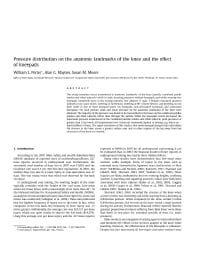Mining Publication: Pressure Distribution on the Anatomic Landmarks of the Knee and the Effect of Kneepads
Original creation date: December 2010
Authors: WL Porter, AG Mayton, SM Moore
This study examines stress transmitted to anatomic landmarks of the knee (patella, combined patella tendon and tibial tubercle) while in static kneeling postures without kneepads and while wearing two kneepads commonly worn in the mining industry. Ten subjects (7 male, 3 female) simulated postures utilized in low-seam mines: kneeling in full flexion; kneeling at 90° of knee flexion; and kneeling on one knee while in one of three kneepad states (no kneepads, non-articulated kneepads, and articulated kneepads). For each posture, peak and mean pressure on the anatomic landmarks of the knee were obtained. The majority of the pressure was found to be transmitted to the knee via the combined patellar tendon and tibial tubercle rather than through the patella. While the kneepads tested decreased the maximum pressure experienced at the combined patellar tendon and tibial tubercle, peak pressures of greater than 25 psi were still experienced over structures commonly injured in mining (e.g. bursa sac - bursitis/Miner’s Knee). The major conclusion of this study is that novel kneepad designs that redistribute the stresses at the knee across a greater surface area and to other regions of the leg away from key structures of the knee are needed.

- Characteristics of Gait in Restricted Vertical Space Versus Unrestricted Walking
- Development and Evaluation of Prototype Kneepads for the Low-Seam Mining Industry
- The Effects of Restricted Workspace on Lumbar Spine Loading
- Evaluation of Muscle Activity, Forces, Stresses, and Moments at the Knee During Kneeling and Squatting Tasks
- Forces and Moments on the Knee During Kneeling and Squatting
- Keeping Knees Healthy in Restricted Work Spaces: Applications in Low-Seam Mining
- Pressures Applied to Anatomical Landmarks of the Knee While in Kneeling Postures
- Refuge Alternatives in Underground Coal Mines
- Thigh-Calf and Heel-Gluteus Contact Forces in High Flexion: Experimental Results
- Wireless Mesh Mine Communication System